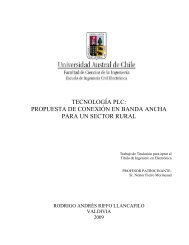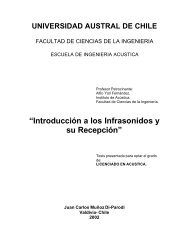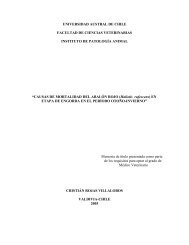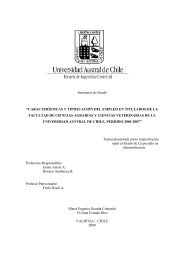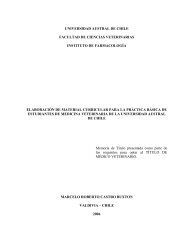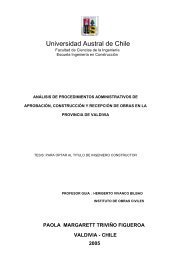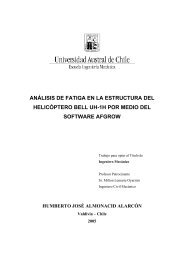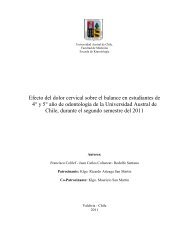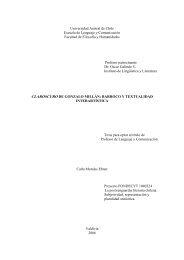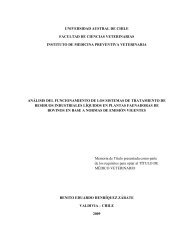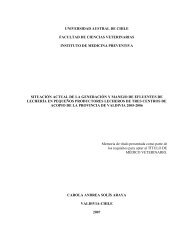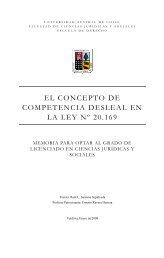Diversidad y control biológico de insectos - CyberTesis UACh ...
Diversidad y control biológico de insectos - CyberTesis UACh ...
Diversidad y control biológico de insectos - CyberTesis UACh ...
Create successful ePaper yourself
Turn your PDF publications into a flip-book with our unique Google optimized e-Paper software.
Introduction.<br />
In last <strong>de</strong>ca<strong>de</strong>s, mo<strong>de</strong>rn agriculture has implied ecosystem simplification, emphasis on<br />
yield and intensive inputs, including pestici<strong>de</strong>s (Banks, 2004). En<strong>de</strong>mic natural enemies of<br />
insect pests represent a fundamental resource for maintaining pest population levels un<strong>de</strong>r<br />
economic thresholds and maximizing their contribution to integrated pest management<br />
(IPM) programs requires a <strong>de</strong>tailed knowledge of their interactions with the target pest<br />
(Furlong et al., 2004), population dynamics and response to disturbances.<br />
Conservation biological <strong>control</strong> has been reinforced because of increasing awareness on<br />
threats posed by alien biological <strong>control</strong> agents to native non-target species (Banks, 2004).<br />
Ground beetles (Coleoptera: Carabidae) are one of the most common families of surface-<br />
active arthropods in agricultural systems (Lövei and Sun<strong>de</strong>rland, 1996; Cole et al., 2002),<br />
while spi<strong>de</strong>rs are increasingly recognized as valuable bio<strong>control</strong> agents (Greenstone, 1999).<br />
Several experimental studies have repeatedly <strong>de</strong>monstrated positive effects of generalist<br />
predators on several crops, including corn (Clark et al., 1994), wheat (Dennis and Wratten,<br />
1991) and oat (Helenius, 1990). Spi<strong>de</strong>rs meet several <strong>de</strong>sirable characteristics as biological<br />
<strong>control</strong> agents: they are relatively long lived, resistant to starvation and <strong>de</strong>siccation, good<br />
dispersers and colonizers and predaceous at all stages of <strong>de</strong>velopment (Greenstone, 1999).<br />
On the other hand, carabids are abundant year roundly and they do not <strong>de</strong>pend on only one<br />
prey species. Many pestici<strong>de</strong>s, including lambda-cyhalothrin, induce significant levels of<br />
mortality in carabids and spi<strong>de</strong>rs (Epstein et al., 2000) thereby impacting their potential to<br />
maintain pests in check.<br />
In Southern Chile, the pasture yield is severely affected by the activity of Dalaca pallens<br />
Blanchard, Dalaca chiliensis (Viette) and Dalaca variabilis larvae (Viette) (Lepidoptera:<br />
Hepialidae). In general, D. pallens is the most abundant species in pastures and >200.000<br />
ha per year are sprayed to <strong>control</strong> it. Insect growth regulators are used against early larval<br />
stages of the pest, while broad spectrum pyrethroids such as lambda-cyhalothrin are<br />
sprayed in Autumn to <strong>control</strong> neonate larvae and in Spring to <strong>control</strong> mature larvae.<br />
Previous studies have shown that the fungus Beauveria bassiana applied at 10 12 spores per<br />
ha has 80-100% of the lambda-cyhalothrin efficacy at <strong>control</strong>ling D. pallens larvae<br />
(Cisternas, 2003).<br />
54



